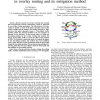Free Online Productivity Tools
i2Speak
i2Symbol
i2OCR
iTex2Img
iWeb2Print
iWeb2Shot
i2Type
iPdf2Split
iPdf2Merge
i2Bopomofo
i2Arabic
i2Style
i2Image
i2PDF
iLatex2Rtf
Sci2ools
ICNS
2009
IEEE
2009
IEEE
Evaluation of Free-Riding Traffic Problem in Overlay Routing and Its Mitigation Method
Recent research on overlay networks has revealed that user-perceived network performance could be improved by an overlay routing mechanism. The effectiveness of overlay routing is mainly a result of the policy mismatch between the overlay routing and the underlay IP routing operated by ISPs. However, this policy mismatch causes a "free-riding" traffic problem, which may become harmful to the cost structure of Internet Service Providers. In the present paper, we define the free-riding problem in the overlay routing and evaluate the degree of free-riding traffic to reveal the effect of the problem on ISPs. We introduce a numerical metric to evaluate the degree of the free-riding problem and confirm that most multihop overlay paths that have better performance than the direct path brings the free-riding problem. We also discuss the guidelines for selecting paths that are more effective than the direct path and that mitigate the free-riding problem.
| Added | 19 Feb 2011 |
| Updated | 19 Feb 2011 |
| Type | Journal |
| Year | 2009 |
| Where | ICNS |
| Authors | Go Hasegawa, Yuichiro Hiraoka, Masayuki Murata |
Comments (0)

